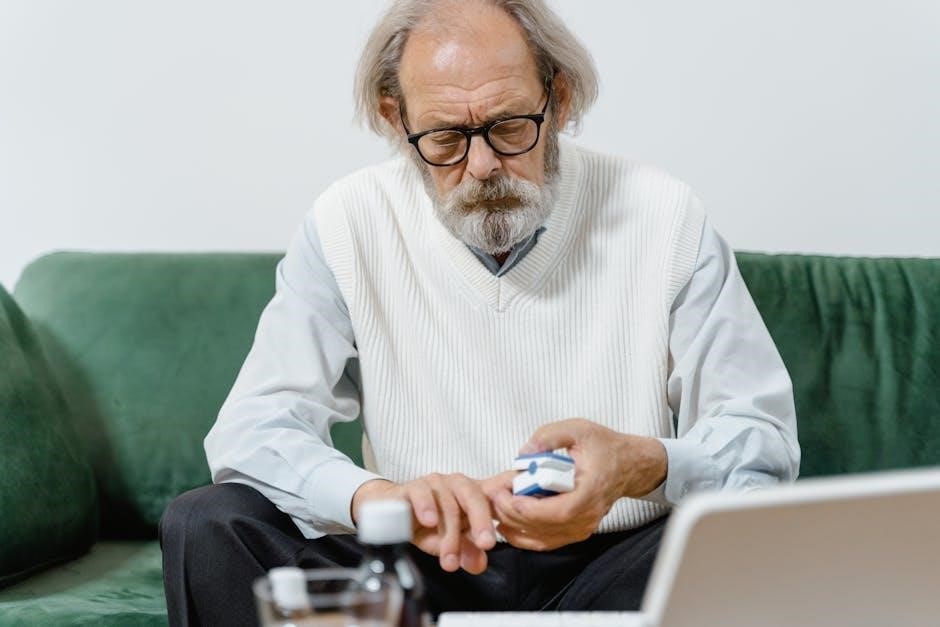
E6000 adhesive is a popular choice among crafters and DIYers, known for its strong, durable bonds on various materials like fabric, glass, metal, and plastic.
1.1 Key Features of E6000 Adhesive
E6000 adhesive is renowned for its exceptional bonding strength, versatility, and durability. It adheres to a wide range of materials, including fabric, glass, metal, plastic, and more. The adhesive is flexible after curing, making it ideal for projects that require movement or stress. E6000 dries quickly, with tack time as short as five minutes, and achieves full cure within 24 hours for thin applications. It is also available in odorless and heavy-duty formulas, catering to different user needs. The self-leveling property ensures a smooth bond, while its resistance to water, heat, and weather makes it suitable for both indoor and outdoor use. These features make E6000 a go-to choice for crafting, jewelry-making, and industrial applications.
1.2 Common Applications of E6000
E6000 adhesive is widely used in various crafting and DIY projects due to its versatility. It is a favorite among jewelry makers for bonding beads, stones, and metals. Crafters rely on it for attaching embellishments like rhinestones and sequins. The adhesive is also ideal for repairing household items, such as reattaching loose handles or fixing torn fabric. Additionally, E6000 is commonly used in industrial settings for heavy-duty applications, where a strong and durable bond is essential. Its ability to adhere to multiple surfaces makes it suitable for both creative and functional projects, ensuring long-lasting results in diverse scenarios.
1.3 Brief History and Development of E6000
E6000 adhesive was developed to meet the growing demand for a versatile and durable bonding solution. Originating in the United States, it quickly gained popularity among crafters, DIY enthusiasts, and professionals. Its formulation was designed to provide a strong, flexible bond on various materials, making it ideal for both creative and industrial applications. Over time, E6000 has evolved to address specific needs, leading to variations like E6000 Plus, an odorless version, and E6000 Industrial for heavy-duty tasks. Its reputation for reliability and performance has solidified its place as a go-to adhesive for projects ranging from jewelry making to home repairs.

Step-by-Step Application Instructions
Clean and prepare surfaces, apply E6000, press firmly, and let dry for 24 hours. Roughen surfaces for better adhesion and test a small area first.
2.1 Preparing Surfaces for Bonding
For optimal bonding, surfaces must be clean, dry, and free of dirt, oils, or grease. Lightly roughen surfaces using sandpaper to enhance adhesion. Ensure all areas are contamination-free before applying E6000 adhesive. This step is crucial for achieving a strong, durable bond. Proper preparation ensures the adhesive spreads evenly and adheres effectively, reducing the risk of failure. Always test a small area first to confirm compatibility and adhesion strength. Following these steps ensures a professional-grade bond, whether for crafts, repairs, or industrial applications.
2.2 Applying E6000 Adhesive
Apply E6000 adhesive directly to the prepared surfaces using the tube’s precision tip. Puncture the inner seal with the pointer cap if it’s your first use. Spread a thin, even layer, ensuring complete coverage of the bonding area. Press the surfaces together firmly to establish immediate tack. For best results, apply gentle pressure to ensure proper contact. Allow the adhesive to set undisturbed for 5-7 minutes to achieve initial adhesion. Avoid over-application, as excess adhesive can be wiped off with a cloth. For intricate projects, use the precision tip to control the amount applied. This ensures a clean, professional finish. Proper application is key to maximizing the adhesive’s performance and durability.
2.3 Drying and Curing Times
E6000 adhesive begins setting in 5 to 7 minutes, with initial adhesion forming quickly. For a thin layer, full cure time is typically 24 hours, while thicker applications may take 48 to 72 hours. Ensure surfaces are clean and dry before application. The adhesive is self-leveling, promoting an even bond. Optimal application occurs between 50°F and 80°F. Once cured, E6000 remains flexible, making it suitable for projects requiring some movement. Proper environmental conditions and application thickness are crucial for achieving the best results. Always follow the manufacturer’s instructions for specific application guidelines to ensure optimal performance and durability of the bond.
2.4 Tips for Optimal Adhesion
To achieve the best results with E6000 adhesive, ensure surfaces are clean, dry, and free of dirt or oils. Lightly roughening the surface can improve adhesion. Apply a thin, even layer of adhesive and press surfaces together firmly. Avoid applying too much glue, as it can lead to mess and prolonged drying times. Work in a well-ventilated area and maintain a temperature range of 50°F to 80°F for optimal bonding. Allow the adhesive to cure undisturbed for at least 24 hours for full strength. For delicate or intricate projects, consider using precision tips for controlled application. Testing adhesion on a small area first is also recommended to ensure compatibility with the materials being used. Proper preparation and patience are key to achieving a strong, lasting bond with E6000 adhesive.

Types of E6000 Products
E6000 offers specialized formulas like E6000 Plus for odorless use, E6000 Industrial for heavy-duty applications, and E6000 Jewelry and Bead Adhesive for precise crafting needs.
3.1 E6000 Plus: Odorless Formula
E6000 Plus offers the same high-performance bonding as the original E6000 but without the strong odor, making it ideal for indoor projects and sensitive environments.
3.2 E6000 Industrial: Heavy-Duty Applications
E6000 Industrial is formulated to meet high-performance demands, making it ideal for heavy-duty applications. It offers a self-leveling formula that creates a strong, flexible bond with various materials, including metal, glass, and plastic. Designed for both DIY enthusiasts and professionals, this adhesive is perfect for challenging projects that require durability and reliability. E6000 Industrial remains flexible after curing, ensuring long-lasting results even under stress or movement. Its versatility makes it suitable for a wide range of tasks, from industrial repairs to complex crafts. With its robust formulation, E6000 Industrial is a go-to choice for projects that demand superior strength and resilience.
3.3 E6000 Jewelry and Bead Adhesive
E6000 Jewelry and Bead Adhesive is specifically designed for crafting intricate jewelry and beadwork. It bonds securely to small items like gemstones, beads, and jewelry metals, ensuring a durable hold. This adhesive is popular among jewelers and crafters for its precision application and strong, long-lasting results. The thick, viscous formula prevents excess flow, making it ideal for delicate pieces. It adheres well to glass, metal, and stone, making it versatile for various jewelry projects. The clear finish ensures invisibility, maintaining the aesthetic of the piece. Jewelers appreciate its reliability for securing small components like cabochons and rhinestones. With E6000 Jewelry and Bead Adhesive, creating professional-looking jewelry is made easy and efficient.

Mixing E6000 with Other Materials
E6000 can be mixed with acrylic paint for custom colors, enhancing its versatility in crafts and repairs. This blend creates unique effects while maintaining strong adhesion properties.
4.1 Mixing with Acrylic Paint
Mixing E6000 with acrylic paint allows for custom color adhesion solutions. This blend is ideal for crafts and repairs, offering vibrant results while maintaining strong bonding properties. Artists and DIYers can achieve unique effects by combining the adhesive’s durability with paint pigments. Ensure the mixture is well-stirred for even color distribution. Apply thinly to avoid cracking. This method is perfect for decorative projects, such as jewelry making or embellishing fabrics. The paint enhances aesthetics without compromising the adhesive’s strength, making it a versatile technique for creative applications. Always test the mixture on a small area first to ensure proper adhesion and color consistency.
4.2 Combining with Other Adhesives
Combining E6000 with other adhesives can enhance specific properties such as flexibility or strength. For instance, mixing with cyanoacrylate (CA glue) may offer quicker drying while maintaining E6000’s flexibility. Epoxy combinations could create a hybrid adhesive, blending E6000’s durability with epoxy’s rigidity, though curing times may vary. Testing small batches is crucial to ensure compatibility and desired results. Always consider the surfaces involved to maintain bonding compatibility. Safety precautions, such as proper ventilation, are essential when mixing adhesives. Experimentation with ratios and applications can lead to specialized uses, but thorough research is recommended to avoid incompatibilities and ensure optimal performance.

Safety Precautions and Storage
Store E6000 at 50°F-80°F, avoiding freezing. Use in well-ventilated areas, avoid inhaling fumes, and keep away from children. Proper storage ensures effectiveness and safety.
5.1 Safety Guidelines for Use
When using E6000 adhesive, ensure the area is well-ventilated to avoid inhaling fumes. Wear protective gloves and eyewear to prevent skin and eye irritation. Avoid applying the adhesive near open flames or sparks, as it is flammable. Keep the product out of reach of children and pets. If skin contact occurs, wash thoroughly with soap and water. In case of eye contact, flush with water for at least 15 minutes and seek medical attention if irritation persists. Follow the manufacturer’s instructions carefully to ensure safe and effective use. Proper safety measures will help prevent accidents and achieve optimal results with your projects.
5.2 Proper Storage Conditions
To maintain the effectiveness of E6000 adhesive, store it in a cool, dry place away from direct sunlight and heat sources. The ideal temperature range for storage is between 50°F (10°C) and 80°F (27°C). Ensure the tube is tightly sealed after use to prevent contamination and drying out. If the product is exposed to freezing temperatures, allow it to reach room temperature before use, as it has freeze/thaw stability. Avoid storing in humid or damp environments, as this can affect the adhesive’s performance. Always check for visible damage or expiration dates before use. Proper storage conditions will ensure the adhesive remains in optimal condition for your projects.